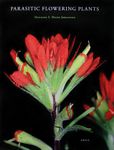Note 10: Book Review: Parasitic Flowering Plants by Henning S. Heide-Jørgensen by Mark Hyde
A Review of Parasitic Flowering Plants by Henning S. Heide-Jørgensen, published by Brill (http://www.brill.nl), Leiden. xiv + 438 pp. ISBN: 978 90 04 16750 6.
Parasitic and (hemiparasitic) plants are very much a feature, although a relatively small one, of the Zimbabwean flora. One thinks immediately of the mistletoes (Loranthaceae, and Viscaceae), the crowded flowers of Berlinianche aethiopica, usually to be found on Julbernardia twigs and the broomrape, Orobanche minor, which we occasionally encounter on our outings.
The lifestyles of these unusual plants are of extraordinary interest; furthermore many such plants are brightly coloured and eye-catching and it is therefore timely to come across a work dedicated to these extraordinary organisms.
As the author remarks in his preface, the "book can be read without special botanical background knowledge" and indeed in the first Chapter, Introduction, the reader is gently and logically introduced to the basic concepts.
Initially, the author clears the decks by discussing exactly what is a parasitic plant.
Parasitic look-alikes such as epiphytic species, which merely grow on other living things but without extracting sustenance, are discussed. Examples of these are epiphytic orchids, strangler figs and plants such as Virginia creepers and ivies with their specialist 'holdfasts'. Other special groups such as the myco-heterotrophic species (formerly known as saprophytic plants) and carnivorous plants, which might be thought to be parasitic, are also defined and differentiated. Parasites are classified into 4 main groups depending on whether they are hemiparasitic or holoparasitic and whether they are root or stem parasites. Parasites form approximately 1% of the world's flora by number and the great majority of those (c. 90%) are hemiparasites. Interestingly, all parasites are dicotyledons, with the exception of the controversial gymnosperm, Parasitaxus usta, which is discussed at length.
In Chapters 2 and 3, Dr Heide-Jørgensen discusses the main hemiparasitic families. The holoparasites, which lack chlorophyll, and which are perhaps the most extraordinary-looking species, are treated in Chapter 4.
In Chapters 5,6 and 7, more general aspects of these plants are discussed, namely how parasites are established (Chapter 5), the relationship between host and parasite (Chapter 6), harmful parasites and their control (Chapter 7) and the ecology and evolution of parasitic plants (Chapter 8). The last chapter ends with a discussion on conservation and the threats to these plants in the wild.
The cover of the book shows an striking North American species, Castilleja coccinea, on a black background. A particular feature of the book, in my opinion, is the large number of excellent photographs, which illustrate and elaborate on the themes being presented.
I have no hesitation in recommending this sumptuously-produced book.
On a more practical level, a number of errors have been discovered following publication and these are listed, together with their correct versions, on the Web on this corrigenda page.
May I say that I enjoyed reading and reviewing the book. It certainly deserves to be a success.
Mark Hyde
Tuesday, 27 January 2009
